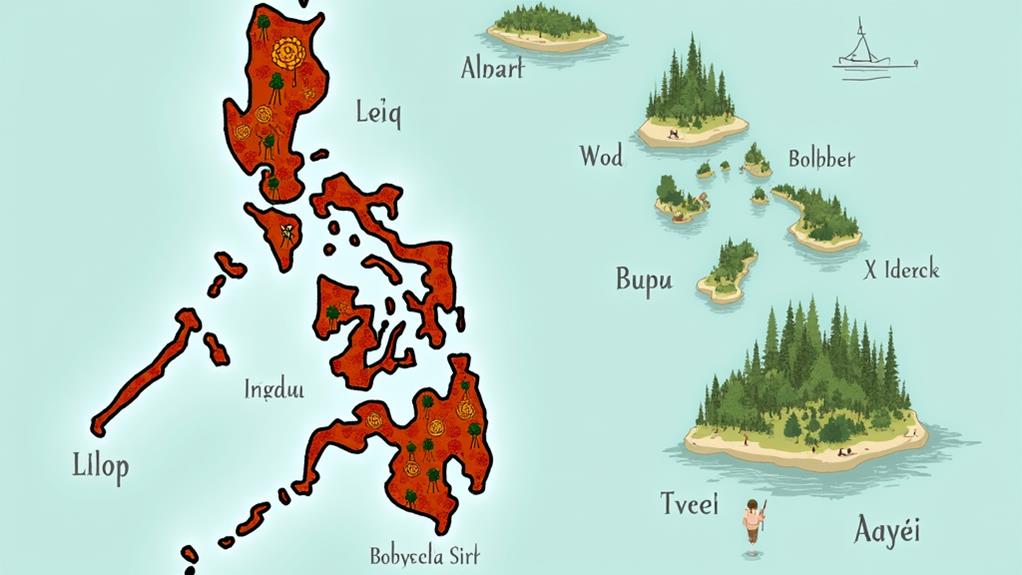Filipino is the national language of the Philippines. This designation was formally established in 1937 by President Manuel L. Quezon. As a result, Filipino has become an integral part of the country's identity.
The language was initially standardized in 1959 as Pilipino. However, the 1987 Constitution officially recognized Filipino as the national language, solidifying its status.
Filipino is an agglutinative language, characterized by a verb-subject-object word order. This means that words are formed by adding prefixes and suffixes to roots. For example, the word "kumakain" (eating) is formed by adding the prefix "kumaka-" to the root word "kain" (eat).
Spanish colonization has had a significant influence on the Filipino language, with approximately one-third of its vocabulary derived from Spanish. This is evident in words such as "gobierno" (government) and "edukasyon" (education).
History of the Filipino Language

The foundation of the Filipino language is based on Tagalog, which was officially declared the national language by President Manuel L. Quezon in 1937. This declaration was a result of the 1935 Constitution, which mandated the development and adoption of a common national language. The 1935 Constitution led to the establishment of the Institute of National Language in 1936.
The development of the Filipino language is also attributed to the preservation of cultural heritage through initiatives such as reviving lost arts. The importance of Philippine craftsmanship, including traditional weaving and pottery skills, has been recognized as an integral part of the country's cultural heritage and national identity. This is reflected in the Filipino language, which has been shaped by the country's history.
In 1959, Pilipino emerged as a standardized form of Tagalog, further solidifying its status. The 1987 Constitution officially designated Filipino as the national language, while promoting its enrichment through other Philippine languages. This blend of influences has contributed to the unique character of the Filipino language.
Approximately one-third of Filipino vocabulary is derived from Spanish, reflecting the historical influence of Spanish colonial rule in the Philippines. This blend of influences has contributed to the unique character of the Filipino language.
Understanding the history behind the Filipino language provides valuable insight into its development and significance in the country's cultural heritage.
Development and Standardization
The development and standardization of the Filipino language progressed significantly with the establishment of the Institute of National Language in 1936. This was in response to the 1935 Constitution's mandate to adopt a common national language.
Several key milestones have contributed to the standardization of the Filipino language. The establishment of Tagalog as the foundation for the national language in 1937 marked the beginning of a standardized language.
The 1973 Constitution further solidified Filipino's status by designating it, along with English, as an official language. This recognition was initially under the name "Pilipino," which was later renamed to "Filipino."
In 1991, the Komisyon sa Wikang Filipino was created to promote research, development, and standardization of Filipino and other Philippine languages. This organization plays a crucial role in ensuring that Filipino remains a vital tool for education and communication in the Philippines.
The development of the Filipino language is characterized by its evolution and enrichment through other Philippine languages. As the language continues to grow, it reflects its unique and distinct identity.
The Komisyon sa Wikang Filipino promotes research and development to maintain the vitality of the language.
| Year | Event | Impact on Standardization |
|---|---|---|
| 1937 | Tagalog is established as the foundation for the national language | Development of a standardized language begins |
| 1973 | The Constitution designates Pilipino (later renamed Filipino) and English as official languages | Recognition of Filipino as an official language alongside English |
| 1991 | The Komisyon sa Wikang Filipino is created | Promotion of research, development, and standardization of Filipino and other Philippine languages |
Official Status and Commemoration

Filipino is the national language of the Philippines, as designated by the 1987 Constitution. It serves as one of the two official languages, alongside English, and functions as the lingua franca for communication among Filipinos.
Although often confused with Tagalog, Filipino is distinct, particularly in official contexts, where Tagalog is used regionally.
The cultural importance of preserving the national language is reflected in the celebration of Buwan ng Wika (National Language Month) in August. This month-long commemoration coincides with the birth month of President Manuel L. Quezon, known as the Father of the National Language.
Various proclamations, including those in 1946, 1954, and 1988, led to the extension of the celebration to a month in 1997.
The Komisyon sa Wikang Filipino (Commission on the Filipino Language), established in 1991, is responsible for promoting and developing the Filipino language.
This commission enriches the language by incorporating elements from other Philippine languages, further solidifying its status as the national language.
Characteristics of the Filipino Language
The Filipino language is an agglutinative language, meaning it relies on the use of affixes and particles to form words and convey meaning. This is a common characteristic among Austronesian languages, which Filipino belongs to. For example, in Filipino, the verb "kain" (to eat) can be modified to "kumain" (ate) by adding the prefix "kum-".
Similarly, the word "laking" (growth) can be formed by adding the suffix "-ing" to the root word "laki" (grow).
Filipino follows a verb-subject-object word order, which is also typical of Austronesian languages. This means that the verb comes first in a sentence, followed by the subject and then the object. For instance, the sentence "Kumain si Juan ng rice" (Juan ate rice) follows this word order.
The language is also syllable-timed and pitch-accent, which means that the rhythm and stress of a sentence are determined by the syllables and pitch of the words. This is distinct from languages that are stress-timed, where the rhythm is determined by the stress on certain words.
The vocabulary of Filipino is derived from various languages, with approximately one-third of it coming from other languages. Spanish influence is most prominent, with many loanwords incorporated into the language. For example, the word "komida" (food) comes from the Spanish word "comida".
Filipino's grammatical structure reflects its cultural significance, particularly in conveying cultural identity and values. The language's use of affixes and particles allows speakers to express nuances in meaning and relationships between words. This is similar to the cultural significance of Regional Variations in Patterns in textiles.
Filipino is mutually intelligible with Tagalog, meaning that speakers of one language can generally understand speakers of the other language. However, Filipino is often regarded as the more prestigious form, used in mass media and formal communication.
Influence of Spanish on Filipino

Spanish colonization's lasting impact on the Philippines is most evident in the linguistic legacy it has left on Filipino, with approximately one-third of the language's vocabulary derived from Spanish. This influence is apparent in areas like religion, where terms such as 'kristiano' (Christian) and 'simbahan' (church) showcase the integration of Spanish influence into everyday life.
Many Filipino terms related to governance, education, and societal structure are borrowed from Spanish, illustrating the historical significance of the language in shaping Filipino identity. For example, 'gobyerno' (government) and 'edukasyon' (education) demonstrate the lasting impact of Spanish on the country's institutions.
The use of local materials like narra and acacia in woodworking has contributed to the development of a unique cultural identity.
The intricate carving techniques introduced during the Spanish colonial era have also shaped the country's woodworking traditions, reflecting the blending of languages and cultures.
The influence of Spanish on Filipino is also evident in the emergence of Chavacano, a Spanish-based creole language. This language is a testament to the complex history of languages in the Philippines and the cultural exchange that occurred during the colonial period.
The Chavacano language is spoken by approximately 700,000 people in the Philippines, primarily in the Zamboanga Peninsula.
Language Planning and Standardization
Language Planning and Standardization in the Philippines
Language planning and standardization is a process that involves the systematic development of a language to reflect a country's linguistic diversity. The Philippines has navigated this process through various constitutional provisions and institutional developments.
The process began in 1935, when the 1935 Constitution mandated the development of a national language based on existing native languages. To achieve this, the Institute of National Language was established in 1936. However, it was not until 1987 that the 1987 Constitution recognized Filipino as the national language alongside English.
In 2004, Filipino was added to the ISO Registry of languages, solidifying its status as the national language of the Philippines. The standardization of Filipino was a gradual process. Initially, Tagalog was adopted as the basis for the national language in 1937. Later, in 1959, the national language was renamed Pilipino.
The Komisyon sa Wikang Filipino, established in 1991, promotes research and development of Filipino and other Philippine languages. These developments reflect the country's efforts to establish a national language that reflects its linguistic diversity.
| Year | Event | Description |
|---|---|---|
| 1935 | 1935 Constitution | Mandated development of a national language based on existing native languages |
| 1936 | Institute of National Language | Established to develop the national language |
| 1987 | 1987 Constitution | Recognized Filipino as the national language alongside English |
| 2004 | ISO Registry | Filipino added to the ISO registry of languages |
Regional Languages in the Philippines

The Philippines is home to over 175 living languages, making it one of the world's most linguistically diverse countries. This linguistic diversity is reflected in the country's rich cultural heritage, including its traditional crafts like Philippine basketry, which showcases unique techniques and designs from various regions.
Regional languages play a significant role in the country's communication dynamics. Tagalog and Cebuano are the most widely spoken native languages. Other regional languages, such as Ilocano, Hiligaynon, and Waray, also hold auxiliary official status.
These regional languages are used for education and local governance in their respective areas, promoting linguistic diversity and facilitating communication among speakers of different languages. The 1987 Constitution promotes the development of Filipino, the national language, by incorporating elements from various regional languages.
Some key features of regional languages in the Philippines include:
- Regional languages like Ilocano, Hiligaynon, and Waray hold official status in their respective areas. This means that they're used in government offices, schools, and other institutions in their respective regions.
- The country's linguistic diversity, with over 175 living languages spoken in the Philippines, is promoted by regional languages. This diversity is a result of the country's geographical location and its history of colonization and trade.
- Regional languages facilitate communication among speakers of different languages, with Filipino serving as a lingua franca. This means that Filipino is used as a common language to facilitate communication among speakers of different regional languages.
- Language policies in the Philippines support bilingual education, allowing the use of both Filipino and regional languages in schools. This policy aims to promote the use of regional languages in education and to preserve the country's linguistic diversity.
Is Tagalog the Foundation of the Filipino National Language?
Tagalog is considered a significant cornerstone in the development of the Filipino national language. As the tagalog most spoken language in philippines, it served as a natural foundation for creating a shared medium of communication that unites the country’s diverse linguistic groups while preserving its cultural heritage.
Language Instruction and Education
Language instruction in the Philippines focuses on promoting linguistic diversity and proficiency in Filipino, the national language.
In the Philippines, Filipino (also known as Tagalog) is a vital part of formal education nationwide. The bilingual education policy, prevalent in many schools, promotes both Filipino and English usage. This policy ensures that students become proficient in the national language and a widely spoken international language.
Filipino is used as the medium of instruction in educational institutions, developing students' speaking, listening, reading, and writing skills.
The education system offers various levels of Tagalog language instruction, from beginning to advanced courses. These courses cater to students' specific needs, and directed studies can be arranged to provide personalized language education.
For example, the Department of Education in the Philippines provides a curriculum that includes language instruction in Filipino, emphasizing the development of reading skills, speaking skills, and overall proficiency in the national language.
By emphasizing language instruction in Filipino, the education system enables students to appreciate the country's linguistic diversity and effectively communicate with Filipinos nationwide.
Questions and Answers
What Is Correct, Tagalog or Filipino Language?
The standardized form of the language is Filipino, which has evolved from Tagalog dialects. When deciding between Tagalog and Filipino, it's essential to understand that both terms refer to closely related languages. However, Filipino is the preferred term as it represents a broader identity, encompassing linguistic diversity and regional languages.
Filipino is based on Tagalog grammar but has distinct literature and vocabulary. The language's evolution is culturally significant, and language preservation efforts focus on standardization. For instance, Filipino vocabulary includes words from other regional languages, such as Cebuano and Ilocano, in addition to Tagalog. This blending of languages is what makes Filipino distinct from Tagalog.
Filipino is the preferred term in official contexts. The Philippine government and educational institutions use Filipino as the official language. This is because Filipino is a more inclusive term that acknowledges the country's linguistic diversity.
Why Is Filipino Called Tagalog?
The term 'Filipino' is often referred to as 'Tagalog' due to the significant influence of the Tagalog dialect on the development of the Filipino language. Tagalog is the primary basis of the Filipino language. This is reflected in the shared grammar, vocabulary, and pronunciation between the two languages.
The reason behind this strong connection lies in the historical and cultural significance of Tagalog. Tagalog literature, history, and culture have greatly influenced the development of Filipino. As a result, the Filipino language has incorporated many elements from Tagalog, making them closely related.
In terms of usage, over 28 million people speak Tagalog, which is a substantial portion of the Philippines' population. This widespread use of Tagalog contributes to the common reference to Filipino as Tagalog.
Is It Filipino or Pilipino?
When considering the terms "Filipino" and "Pilipino," you may wonder which one is the correct term for the national language. The correct term is "Filipino."
Historically, "Pilipino" referred to the language based on Tagalog, which was the country's primary language. However, in 1987, the Philippine Constitution declared that the national language would be known as "Filipino." This change reflected the language's broader cultural significance, encompassing regional dialects and linguistic diversity.
The evolution of the language is rooted in the country's national pride and efforts to preserve the language through bilingual education. For example, the Philippine Department of Education implemented the Mother Tongue-Based Multilingual Education (MTB-MLE) program, which aims to promote the use of regional languages in schools.
This program ultimately shapes the Filipino identity by promoting linguistic diversity and cultural awareness.
What Language Is Filipino Made Of?
When exploring the composition of the Filipino language, it is primarily based on the Tagalog regional dialect. This dialect has undergone significant historical development, resulting in a unique blend of languages.
The Filipino language's vocabulary includes borrowings from other languages, such as Spanish (around 30% of the vocabulary) and English (around 20% of the vocabulary). This showcases the language evolution and adaptation of the Filipino people to their cultural environment.
The development of the Filipino language is a result of regional dialects and language standardization efforts. In 1937, the Institute of National Language was established to create a standardized national language.
In 1987, the Filipino language was officially recognized as the national language of the Philippines.
This unique blend of languages has ultimately contributed to a distinct national identity for the Filipino people.